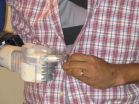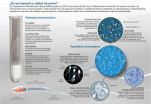(Press-News.org) Wide differences in death rates from disease still persist throughout England – but effective healthcare can help to reduce these inequalities, a new study has discovered.
Researchers from the University of Leicester led a two-year project funded by the National Institute for Health Research (NIHR) into why differences in death rates from diseases like heart disease, strokes, lung disease and cancers still persist.
They found that age and poverty were among the biggest factors that accounted for the differences – but they also discovered that effective delivery of healthcare could lessen the impact of these health inequalities.
The research, published in PLOS ONE and funded by the NIHR Collaboration for Leadership in Applied Research and Care (CLAHRC) for Leicestershire, Northamptonshire and Rutland, was led by a University of Leicester team including Louis S Levene, honorary clinical fellow, John Bankart, lecturer in medical statistics, Kamlesh Khunti, Professor of Primary Care Diabetes and Vascular Medicine and Richard Baker, Professor of Quality in Health Care and Director of the NIHR CLAHRC.
Dr Levene, a full time GP, said: "Our research examined the wide variations in death rates from major diseases between different areas in England, despite an overall steady decline.
"Our aim is to better understand what factors, particularly in the delivery of healthcare, might explain these variations in death rates. This knowledge could help local health authorities to focus on those measures (such as detecting more people with high blood pressure) that are more likely to reduce these 'health inequalities' over time and to tailor the delivery of these measures to the needs of the local population.
"Looking across all the primary care trusts in England, the main predictors of variations in death rates were population characteristics, especially age and socio-economic deprivation. However, the study showed that for each additional 1% of people known to have raised pressure, there is a decrease in coronary heart disease death rates of 3% and in stroke death rates of 6%.
"Also, for each 1% increase in the percentage of patients recalling being better able to see their preferred doctor, there was a decrease in lung disease death rates of 0.7% and in cancer death rates of 0.3%. These effects are independent of the other factors studied. Variation in the performance of GPs was generally not associated with variations in death rates."
Dr Levene said that, previously, it has not been entirely understood why there are still such variations in death rates in different primary care trusts in England.
He added: "This study successfully tested a new conceptual model that variations in death rates are mainly predicted by variations in the characteristics of populations, but that these effects are altered by some healthcare activities."
Professor Richard Baker, Director of the NIHR CLAHRC and based in the University of Leicester Department of Health Sciences added: "At a time of big changes to how the NHS, especially in the community, will deliver healthcare and associated financial constraints, those who commission healthcare need information about what aspects of healthcare are most likely to benefit the health of populations as a whole. Despite the universal provision of healthcare by the NHS, there remain huge variations in health outcomes.
"This study reminds us all of persisting health inequalities, and challenges for the future of healthcare. Health inequalities are mainly predicted by variations in the characteristics of local populations; healthcare can only partly combat this effect, but it is important that it does so through interventions that include measuring blood pressure, and offering a service that enables people who want to to see the same doctor.
"Healthcare system reforms should therefore aim to deliver cost-effective evidence-based interventions to whole populations, and foster sustained patient-doctor partnerships."
Dr Levene concluded: "It is gratifying to have completed a challenging project, which has the potential to inform and influence decisions about how healthcare needs to be delivered to local populations. It also demonstrates that our Department has increasing expertise in analysing important public health issues. Personally, I am excited by the opportunity that I, an ordinary full-time GP, have had to work with high-powered academic colleagues and to complete a piece of research accepted for publication in a peer-reviewed academic journal."
###
The views arising from this independent research are those of the authors and not necessarily those of the NHS, the NIHR or the Department of Health.
Note to newsdesk:
For interviews contact:
Dr Levene on lsl7@le.ac.uk; 0116 2958282
Professor Baker on rb14@le.ac.uk; 0116 252 3202
Health inequalities could be reduced by more effective health care, says new study
Research led by University of Leicester discovers how effective healthcare can reduce toll from major diseases like stroke, heart disease and cancer
2012-10-31
ELSE PRESS RELEASES FROM THIS DATE:
Navy oceanographers delve deeper in wave data to improve forecasts
2012-10-31
WASHINGTON--Around the globe, mariners and navies alike have long observed and included weather and sea states in navigational planning when plotting course or developing military strategy. And although forecasting had become an integral function by the start of the 20th century, these predictions were often crude and qualitative.
For the U.S. Navy, the years 1941 through 1946 provided an unusual stimulus to ocean wave research, according to pioneer World War II oceanographer Charles Bates. During this brief five-year period, theory, observation, and prediction of sea, ...
Sustainable cities must look beyond city limits
2012-10-31
City leaders aspiring to transform their cities into models of sustainability must look beyond city limits and include in their calculation the global flow of goods and materials into their realm, argue researchers in the Royal Swedish Academy of Sciences journal Ambio.
Many cities are now developing sustainable strategies to reduce pollution and congestion, improve the quality of life of their citizens, and respond to growing concern about human impact on climate and the environment. But sustainable city initiatives often ignore the environmental footprint from imported ...
New metric to track prosthetic arm progress
2012-10-31
PROVIDENCE, R.I. [Brown University] — Amputees with a new prosthetic arm must learn how to use their device to perform everyday tasks that were once second nature. Taking off a shirt becomes a conscious, multistep effort: grasp the shirt, lift the shirt over the head, pull arms through the sleeves, place the shirt on the table, let go of the shirt.
In the best cases of treatment, patients work with teams of doctors, prosthetists, and therapists to learn how their new limbs can help them regain function and quality of life. But clinicians have had few tools to assess ...
New hope for survivors of stroke and traumatic brain injury
2012-10-31
A new ground-breaking study about to be published in the Adis journal CNS Drugs provides clinical evidence that, for the first time, chronic neurological dysfunction from stroke or traumatic brain injury can rapidly improve following a single dose of a drug that targets brain inflammation, even years after the stroke or traumatic event.
The observational study¹ of 629 patients, conducted over the course of nearly two years, documents a diverse range of positive effects, including statistically significant rapid clinical improvement in motor impairment, spasticity, cognition, ...
Graphene mini-lab
2012-10-31
A team of physicists from Europe and South Africa showed that electrons moving randomly in graphene can mimic the dynamics of particles such as cosmic rays, despite travelling at a fraction of their speed, in a paper about to be published in EPJ B.
Andrey Pototsky and colleagues made use of their knowledge of graphene, which is made of a carbon layer, one atom thick, and packed in a honeycomb lattice pattern. In such material the interaction of electrons with atoms changes the effective mass of the electrons. As a result, the energy of electrons in graphene becomes similar ...
First-ever 3-D stress map of developing embryonic heart sheds light on why defects form
2012-10-31
WASHINGTON, Oct. 31—As a human fetus develops, its heart has to keep pace with the new body's ever-growing demands. Much of this is controlled by following genetic blueprints, but the embryonic heart also matures in response to the intense stresses of pumping blood. For the first time, researchers have been able to visualize in 3-D the stresses induced by flowing blood in an embryonic heart. The technique, which promises to provide new insight into how and why heart defects develop, is described in a paper published today in the Optical Society's (OSA) open-access journal ...
Unlocking the secrets of DNA repair
2012-10-31
Scientists from the University of Sheffield have unlocked one of the secrets to DNA repair –helping doctors identify DNA base damage and a patient's susceptibility to certain types of cancer.
Groundbreaking research led by Dr David Williams from the University of Sheffield's Department of Chemistry and an international collaboration of expert researchers has discovered how some proteins recognise damaged bases within DNA which, if untreated, could lead to cancer.
Dr Williams said: "Proteins carry out all the day-to-day processes needed for survival. If the DNA bases ...
How and why herpes viruses reactivate to cause disease
2012-10-31
The mere mention of the word "herpes" usually conjures negative images and stereotypes, but most people have been infected with some form of the virus. For most, a sore appears, heals and is forgotten, although the virus remains latent just waiting for the right circumstances to come back. Now, the mystery behind what triggers the virus to become active again is closer to being solved thanks to new research published in the Journal of Leukocyte Biology's November 2012 issue. In the report, scientists show how the immune system may lose its control over the virus when facing ...
Men who do exercise produce better quality semen
2012-10-31
A new study conducted by researchers at the University of Cordoba links moderate physical activity in males with better hormone levels and sperm characteristics that favour reproduction compared to sedentary men.
Semen quality at large has dropped in the last 50 years. Amongst other factors, this is due to exposure to external agents and alcohol and tobacco consumption. This decline in sperm properties has caused an increase in reproductive problems.
Therefore, experts have studied the possible relationship between sperm quality and lifestyle habits in males. Published ...
Microscopic packets of stem cell factors could be key to preventing lung disease in babies
2012-10-31
Boston, Mass.—Researchers at Boston Children's Hospital have found that microscopic particles containing proteins and nucleic acids called exosomes could potentially protect the fragile lungs of premature babies from serious lung diseases and chronic lung injury caused by inflammation.
The findings explain earlier research suggesting that while transplanting a kind of stem cell called mesenchymal stem cells (MSCs) could help reduce lung injury and prevent inflammation in a mouse model, the fluid in which the cells were grown was more effective than the cells themselves.
The ...
LAST 30 PRESS RELEASES:
Electrodes created using light
Second-hand gift-giving is a well-deliberated decision
How human interaction drove evolution to make bears less aggressive
National Poll: Few parents offer teens guidance on healthy eating during holiday season
Cannabis derivatives could provide new ovarian cancer treatments
Raising strong yeast as a petroleum substitute
Clues to the origin of hot Jupiters hidden in their orbits
Canada’s reduced pledge to Global Fund will impact domestic health
1 in 4 children with major traumatic injuries not cared for in pediatric trauma centres
Duke and Duke-NUS’ joint cross-population research to uncover "East-West" differences in disease and care
Scientists to ‘spy’ on cancer- immune cell interactions using quantum technology breakthrough
Tech savvy users have most digital concerns
Making lighter work of calculating fluid and heat flow
Normalizing blood sugar can halve heart attack risk
Lowering blood sugar cuts heart attack risk in people with prediabetes
Study links genetic variants to risk of blinding eye disease in premature infants
Non-opioid ‘pain sponge’ therapy halts cartilage degeneration and relieves chronic pain
AI can pick up cultural values by mimicking how kids learn
China’s ecological redlines offer fast track to 30 x 30 global conservation goal
Invisible indoor threats: emerging household contaminants and their growing risks to human health
Adding antibody treatment to chemo boosts outcomes for children with rare cancer
Germline pathogenic variants among women without a history of breast cancer
Tanning beds triple melanoma risk, potentially causing broad DNA damage
Unique bond identified as key to viral infection speed
Indoor tanning makes youthful skin much older on a genetic level
Mouse model sheds new light on the causes and potential solutions to human GI problems linked to muscular dystrophy
The Journal of Nuclear Medicine ahead-of-print tip sheet: December 12, 2025
Smarter tools for peering into the microscopic world
Applications open for funding to conduct research in the Kinsey Institute archives
Global measure underestimates the severity of food insecurity
[Press-News.org] Health inequalities could be reduced by more effective health care, says new studyResearch led by University of Leicester discovers how effective healthcare can reduce toll from major diseases like stroke, heart disease and cancer




